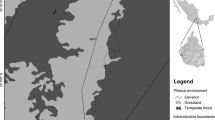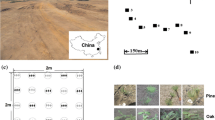Abstract
Cenococcum geophilum Fr., one of several ectomycorrhizal species associated with black pine (Pinus thunbergii Parl.), is dominant in the coastal forests of Japan, even under adverse abiotic environmental conditions. In these forests, many tonnes of Sumipine® (fenitrothion) are applied every year to protect P. thunbergii from pine wilt disease, which is transmitted by a beetle. Here, we examined the effect of this insecticide on the species of fungi found as ectomycorrhizae on naturally regenerated P. thunbergii seedlings collected from coastal forest sites that had or had not been sprayed with fenitrothion. The proportion of C. geophilum ectomycorrhizae on black pine root tips was significantly higher in areas where fenitrothion had been applied than in areas where it had not. We measured the in vitro mycelial growth of C. geophilum as well as other ectomycorrhizal fungi of coastal black pine, Rhizopogon roseolus (Corda) Th. Fr. and Pisolithus arhizus (Scop.) Rauschert, at three levels of fenitrothion (density: 1.32 g/cm3), i.e., 0, 0.1 and 0.2 mL L−1. The growth of all three species decreased significantly as the fenitrothion dosage increased. However, the reduction of mycelial growth in response to fenitrothion was lower in C. geophilum than in the other two species. These results suggest that C. geophilum has a high tolerance for fenitrothion, which may explain its dominance over other ectomycorrhizal species in coastal forests in Japan where fenitrothion is routinely sprayed.



Similar content being viewed by others
References
Agerer R (1994) Characterization of ectomycorrhiza. In: Norris JR, Read DJ, Varma AK (eds) Techniques for mycorrhizal research. Academic Press, San Diego, pp 25–74
Akema T, Futai K (2005) Ectomycorrhizal development in Pinus thunbergii stand in relation to location on a slope and effect on tree mortality from pine wilt disease. J For Res 10:93–99
Aučina A, Rudawska M, Leski T, Ryliškis D, Pietras M, Riepšas E (2011) Ectomycorrhizal fungal communities on seedlings and conspecific trees of Pinus mugo grown on the coastal dunes of the Curonian Spit in Lithuania. Mycorrhiza 21:237–245
Bates D, Maechler M, Bolker B, Walker S (2015) Fitting linear mixed-effects models Using lme4. J Stat Softw 67:1–48
Bledsoe CS (1992) Physiological ecology of ectomycorrhizae: implications for field application. In: Allen MF (ed) Mycorrhizal functioning: an integrative plant-fungal process. Chapman Hall, New York, pp 424–437
Buscot F, Weber G, Obervinkler F (1992) Interactions between Cylindrocarpon destructans and ectomycorrhizas of Picea abies with Laccaria laccata and Paxillus involutus. Trees 6:83–90
Corkidi L, Bohn J, Evans M (2009) Effects of bifenthrin on mycorrhizal colonization and growth of corn. Hort Technol 19:809–812
FAO-UNESCO (1990) Soil map of the world. Revised legend. Reprinted with corrections. World soil resources report 60. FAO, Rome
Fernandez CW, Koide RT (2013) The function of melanin in the ectomycorrhizal fungus Cenococcum geophilum under water stress. Fungal Ecol 6:479–486
Fernández-Toirán LM, Águeda B (2007) Fruit bodies of Cenococcum geophilum. Mycotaxon 100:109–114
Finlay RD, Read DJ (1986) The structure and function of the vegetative mycelium of ectomycorrhizal plants. II. The uptake and distribution of phosphorus by mycelial strands interconnecting host plants. New Phytol 103:157–165
Fox J, Weisberg S (2011) An R Companion to applied regression, 2nd edn. Sage, Thousand Oaks CA, URL: http://socserv.socsci.mcmaster.ca/jfox/Books/Companion
Fushiwaki Y, Fujimori H (2003) Present status and problems for environmental pollution by spraying chemicals for control of pine sawyer beetles (in Japanese). JSSE 42:166–171
Hasselquist N, Germino MJ, McGonigle T, Smith WK (2005) Variability of Cenococcum colonization and its ecophysiological significance for young conifers at alpine-treeline. New Phytol 165:867–873
Hothorn T, Bretz F, Westfall P (2008) Simultaneous inference in general parametric models. Biom J 50:346–363
Ichikawa Y, Sasaki M, Tabata K, Motoyama N (2009) Monitoring drift of fenitrothion MC, following application by a radio-controlled helicopter on pine trees in Akita prefecture (in Japanese). JJPS 34:45–56
Ikegami M, Jenkins TAR (2018) Estimate global risks of a forest disease under current and future climates using species distribution model and simple thermal model – Pine Wilt disease as a model case. For Ecol Manage 409:343–352
Kishi Y (1995) The pine wood nematode and the Japanese pine sawyer. Thomas, Tokyo
Likas DT, Tsiropoulos NG (2007) Behaviour of fenitrothion residues in leaves and soil of vineyard after treatment with microencapsulate and emulsified formulations. Int J Environ Anal Chem 87:927–935
LoBuglio KF (1999) Cenococcum. In: Cairney JWG, John WG, Chambers SM (eds) Ectomycorrhizal fungi key genera in profile. Springer, Berlin, pp 287–309
Marx DH (1969) The influence of ectotrophic mycorrhizal fungi on the resistance of pine roots to pathogenic infections. I. Antagonism of mycorrhizal fungi to root pathogenic fungi and soil bacteria. Phytopathol 59:153–163
Massicotte HB, Trappe JM, Peterson RL, Melville LH (1992) Studies on Cenococcum geophilum. II. Sclerotium morphology, germination, and formation in pure culture and growth pouches. Can J Bot 70:125–132
Matsuda Y, Nakanishi K, Ito S (2003) Effects of sodium chloride on the growth of Pinus thunbergii and ectomycorrhizal fungi (in Japanese). Chubu For Res 51:205–208
Matsuda Y, Sugiyama F, Nakanishi K, Ito S (2006) Effects of sodium chloride on growth of ectomycorrhizal fungal isolates in culture. Mycosci 47:212–217
Matsuda Y, Hayakawa S, Ito S (2009a) Local and microscale distributions of Cenococcum geophilum in soils of coastal pine forests. Fungal Ecol 2:31–35
Matsuda Y, Noguchi Y, Ito S (2009b) Ectomycorrhizal fungal community of naturally regenerated Pinus thunbergii seedlings in a coastal pine forest. J For Res 14:335–341
Matsuda Y, Kimura Y, Nakamura K, Ito S (2011) Occurrences of Cenococcum geophilum in coastal pine forests at Aomori and Kagosima Prefectures (in Japanese). Chubu For Res 59:239–242
Matsuda Y, Takeuchi K, Obase K, Ito S (2015) Spatial distribution and genetic structure of Cenococcum geophilum in coastal pine forests in Japan. FEMS Microbiol Ecol 91:1–14
Matsuda Y, Yamakawa M, Inaba T, Obase K, Ito S (2017) Intraspecific variation in mycelial growth of Cenococcum geophilum isolates response to salinity gradients. Mycoscience 58:369–377
Mexal J, Reid CPP (1973) The growth of selected mycorrhizal fungi in response to induced water stress. Can J Bot 51:1579–1588
Murai H, Ishikawa M, Endo J, Tadaki R (1992) The coastal forest in Japan – its multiple functions and use. Soft Science, Tokyo
Obase K, Cha JY, Lee JK, Lee SY, Lee JH, Chun KW (2009) Ectomycorrhizal fungal communities associated with Pinus thunbergii in the eastern coastal pine forests of Korea. Mycorrhiza 20:39–49
Obase K, Lee JK, Lee SY, Chun KW (2011) Diversity and community structure of ectomycorrhizal fungi in Pinus thunbergii coastal forests in the eastern region of Korea. Mycoscience 52:383–391
Obase K, Douhan GW, Matsuda Y, Smith ME (2017) Progress and challenges in understanding the biology, diversity, and biogeography of Cenococcum geophilum. In: Tedersoo L (ed) Biogeography of Mycorrhizal Symbiosis, vol 230. the series Ecological Studies. Springer, Cham pp, pp 299–317
Obase K, Douhan GW, Matsuda Y, Smith ME (2018) Isolation source matters: sclerotia and ectomycorrhizal roots provide different views of genetic diversity in Cenococcum geophilum. Mycologia 110:473–481
Ohkawa H, Mikami N, Miyamoto J (1974) Photodecomposition of Sumithion [O, O-dimethyl-O-(3-methyl-4-nitro-phenyl)-phosphorothioate]. Agr Biol Chem 38:2247–2255
Peter M, Kohler A, Ohm RA, Kuo A, Krützmann J, Morin E, Arend M, Barry KW, Binder M, Choi C et al (2016) Ectomycorrhizal ecology is imprinted in the genome of the dominant symbiotic fungus Cenococcum geophilum. Nat Commun 7:1–15
R Development Core Team (2017) R: A language and environment for statistical computing, R Foundation for Statistical Computing, Vienna, Austria. URL https:// www.R-project.org/
Ramos MA, Sousa NR, Franco AR, Costa V, Oliveira RS, Castro PML (2013) Effect of diflubenzuron on the development of Pinus pinaster seedlings inoculated with the ectomycorrhizal fungus Pisolithus tinctorius. Environ Sci Pollut R 20:582–590
Reddy MS, Natarajan K (1994) Effect of a synthetic pyrethroid on the growth of ectomycorrhizal fungi and mycorrhiza formation in Pinus patula. Mycorrhiza 5:115–117
Sainz MJ, González-Penalta B, Vilariño A (2006) Effects of hexachlorocyclohexane on rhizosphere fungal propagules and root colonization by arbuscular mycorrhizal fungi in Plantago lanceolata. Eur J Soi Sci 57:83–90
Saleh-Rastin N (1976) Salt tolerance of the mycorrhizal fungus Cenococcum graniforme (Sow.) Ferd. Eur J For Pathol 6:184–187
Smith SE, Read DJ (2008) Mycorrhizal symbiosis, 3rd edn. Academic Press, London
Spatafora JW, Owensby CA, Douhan GW, Boehm EWA, Schoch CL (2012) Phylogenetic placement of the ectomycorrhizal genus Cenococcum in Gloniaceae (Dothideomycetes). Mycologia 104:758–765
Spillner CJ, DeBaun JR, Menn JJ (1979) Degradation of fenitrothion in forest soil and effects on forest soil microbes. J Agric Food Chem 27:1054–1060
Takeuchi Y, Matsuda Y, Ito S (2010) Occurrence rates of Cenococcum geophilum in coastal pine forests at Tokai areas (in Japanese). Chubu For Res 58:19–20
Takimoto Y, Hirata M, Inui H, Miyamoto J (1976) Decomposition and leaching of radioactive Sumithion in 4 different soils under laboratory conditions. J Pesticide Sci 1:131–143
Taniguchi T, Kanzaki N, Tamai S, Yamanaka N, Futai K (2007) Does ectomycorrhizal fungal community structure vary along a Japanese black pine (Pinus thunbergii) to black locust (Robinia pseudoacacia) gradient? New Phytol 173:322–334
Trappe JM (1962) Cenococcum graniforme - its distribution, ecology, mycorrhiza formation, and inherent variation. Dissertation, University of Washington
Trappe JM, Molina R, Castellano M (1984) Reactions of mycorrhizal fungi and mycorrhiza formation to pesticides. Ann Rev Phytopathol 22:331–359
van der Heijden MGA, Martin FM, Selosse M-A, Sanders IR (2015) Mycorrhizal ecology and evolution: the past, the present, and the future. New Phytol 205:1406–1423
Vicente C, Espada M, Vieira P, Mota M (2012) Pine wilt disease: a threat to European forestry. Eur J Plant Pathol 133:89–99
Wang C, Brunner I, Zong S, Li MH (2019) The dynamics of living and dead fine roots of forest biomes across the northern hemisphere. Forests 10:953
Yoshida N (2006) A strategy for controlling pine wilt disease and its application on-site (in Japanese). J Jpn For Soc 88:422–428
Zhao BG, Futai K, Sutherland JR, Takeuchi Y (2008) Pine wilt disease. Springer, Tokyo
Acknowledgements
This study was supported by the Aichi Prefectural Forestry Research Institute, Graduate School of Bioresources, Mie University, and the Graduate School of Bioagricultural Sciences, Nagoya University. The authors wish to thank all the members of these facilities for their help during our study. The authors also wish to thank the editor and two anonymous reviewers for their helpful comments on the draft manuscript.
Author information
Authors and Affiliations
Corresponding author
Supplementary Information
Below is the link to the electronic supplementary material.
Rights and permissions
About this article
Cite this article
Nakashima, H., Matsuda, Y. & Hijii, N. An ectomycorrhizal fungus, Cenococcum geophilum, in a coastal pine forest has a high tolerance for an insecticide used to control pine wilt disease. Landscape Ecol Eng 17, 401–409 (2021). https://doi.org/10.1007/s11355-021-00455-w
Received:
Revised:
Accepted:
Published:
Issue Date:
DOI: https://doi.org/10.1007/s11355-021-00455-w




